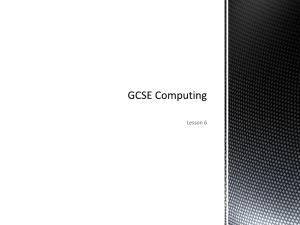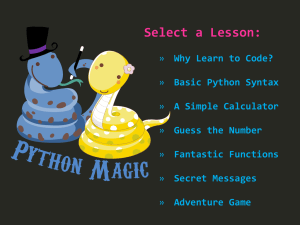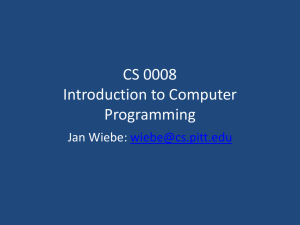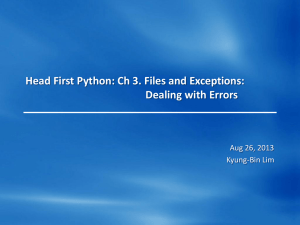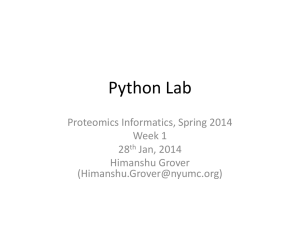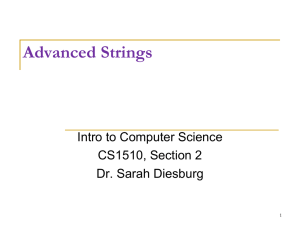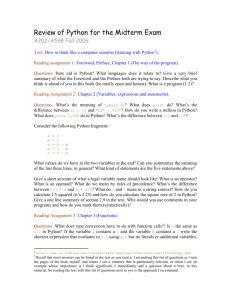Python Basics
advertisement
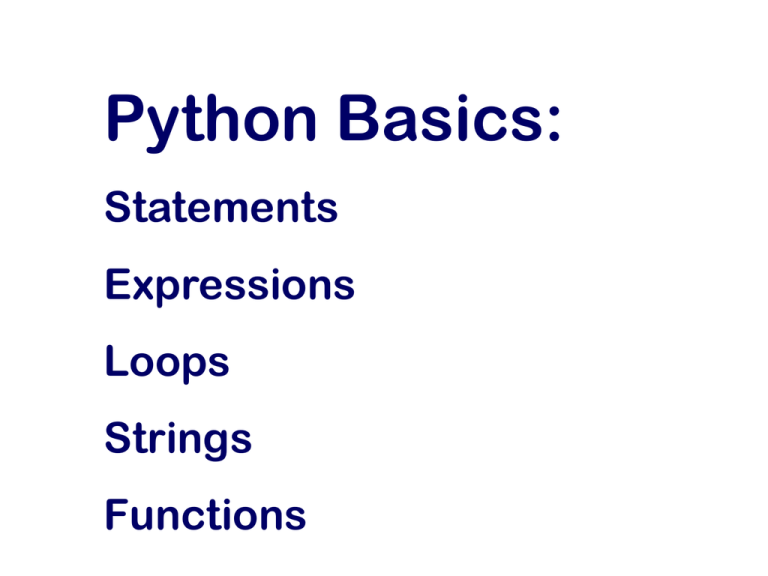
Python Basics:
Statements
Expressions
Loops
Strings
Functions
Program
• A program is a sequence of instructions or
statements.
• To run a program is to:
– create the sequence of instructions according to
your design and the language rules
– turn that program into the binary commands the
processor understands
– give the binary code to the OS, so it can give it to
the processor
– OS tells the processor to run the program
– when finished (or it dies :-), OS cleans up.
Example Code Listing
# 1. prompt user for the radius,
# 2. apply the area formula
# 3. print the results
import math
radiusString = input("Enter the radius of your circle:")
radiusFloat = float(radiusString)
circumference = 2 * math.pi * radiusFloat
area = math.pi * radiusFloat * radiusFloat
print()
print("The cirumference of your circle is:",circumference,\
", and the area is:",area)
Getting Input
The function: input(“Give me a value”)
• prints “Give me a value” on the screen and
waits until the user types something
(anything), ending with [Enter] key
• Warning! Input() returns a string (sequence
of characters), no matter what is given. (‘1’ is
not the same as 1, different types)
Convert from string to integer
• Python requires that you must convert a sequence
of characters to an integer
• Once converted, we can do math on the integers
Import of Math
• One thing we did was to import the math
module with import math
• This brought in python statements to
support math (try it in the python window)
• We precede all operations of math with
math.xxx
• math.pi, for example, is pi.
math.pow(x,y) raises x to the yth power.
Assignment Statement
The = sign is the assignment symbol
• The value on the right is associated with the
variable name on the left
• A variable is a named location that can store
values (information). A variable is somewhat
like a file, but is in memory not on the HD.
• = Does not stand for equality here!
• What “assignment” means is:
– evaluate all the “stuff” on the rhs (right-hand-side)
of the = and take the resulting value and
associate it with the name on the lhs (left-h-s)
Printing Output
myVar = 12
print(‘My var has a value of:’,myVar)
• print() function takes a list of elements to
print, separated by commas
– if the element is a string, prints it as is
– if the element is a variable, prints the value
associated with the variable
– after printing, moves on to a new line of output
Syntax
• Lexical components.
• A Python program is (like a hierarchy):.
– A module (perhaps more than one)
– A module is just a file of python commands
– Each module has python statements
– Statements may have expressions
– Statements are commands in Python.
– They perform some action, often called a side
effect, but do not return any values
– Expressions perform some operation and return
a value
Side Effects and Returns
• Make sure you understand the difference.
What is the difference between a side
effect and a return?
• 1 + 2 returns a value (it’s an expression).
You can “catch” the return value.
However, nothing else changed as a result
• print “hello” doesn’t return anything, but
something else - the side effect - did
happen. Something printed!
Whitespace
• white space are characters that don’t print
(blanks, tabs, carriage returns etc.
• For the most part, you can place “white
space” (spaces) anywhere in your program
• use it to make a program more readable
• However, python is sensitive to end of line
stuff. To make a line continue, use the \
print “this is a test”, \
“ of continuation”
prints
this is a test of continuation
Python
Tokens
Keywords:
You are
prevented
from using
them in a
variable name
and
del
from
not
while
as
elif
global
or
with
assert
else
if
pass
yield
break
except
import
print
class
exec
in
raise
continue finally
is
return
def
lambda try
for
Reserved operators in Python (expressions):
+
-
*
**
/
//
<<
>>
&
|
^
~
<
>
<=
>=
==
!=
%
<>
Python Punctuators
• Python punctuation/delimiters ($ and ? not
allowed).
‘
“
#
\
(
)
[
]
{
}
,
:
.
`
=
;
+=
-=
*=
/=
//=
%=
&=
|=
^=
>>= <<=
**=
@
Operators
• Integer
– addition and subtraction: +, – multiplication: *
– division
• quotient: //
• remainder: %
• Floating point
– add, subtract, multiply, divide: +, -, *, /
Loops: Repeating Statements
Draw Square:
from turtle
import *
forward(100)
left(90)
forward(100)
left(90)
forward(100)
left(90)
forward(100)
Repeat the following steps 4 times:
• Draw a line
• Turn left
from turtle import *
for count in range(4):
forward(100)
left(90)
While and For Statements
• The for statement is useful
for iteration, moving through
all the elements of data
structure, one at a time.
• The while statement is the
more general repetition
construct. It repeats a set of
statements while some
condition is True.
from turtle import *
for count in
range(4):
forward(100)
left(90)
from turtle import *
count=1
while count<=4:
forward(100)
left(90)
count=count+1
Range Function
• The range function generates a sequence
of integers
• range(5) => [0, 1, 2, 3, 4]
– assumed to start at 0
– goes up to, but does not include, the provided
number argument.
• range(3,10) => [3, 4, 5, 6, 7, 8, 9]
– first argument is the number to begin with
– second argument is the end limit (not included!)
Iterating Through the Sequence
for num in range(1,5):
print(num)
• range generates the sequence [1, 2, 3, 4]
• for loop assigns num each of the values in
the sequence, one at a time in sequence
• prints each number (one number per line)
• list(range(-5,5)) # in shell to show range
Sequence of Characters
• We’ve talked about strings being a
sequence of characters.
• A string is indicated between ‘ ‘ or “ “
• The exact sequence of characters is
maintained, including spaces.
• Does NOT include multiple lines
• Use backslash \ for line continuation
And Then There is “““ ”””
• Triple quotes preserve both vertical
and horizontal formatting of the string
• Allow you to type tables, paragraphs,
whatever and preserve the formatting
(like <pre> tag in html)
“““this is
a test
of multiple lines”””
Strings
Can use single or double quotes:
• S = “spam”
• s = ‘spam’
Just don’t mix them!
• myStr = ‘hi mom” ERROR
Inserting an apostrophe:
• A = “knight’s” # mix up the quotes
• B = ‘knight\’s’ # escape single quote
The Index
• Because the elements of a string are a
sequence, we can associate each element
with an index, a location in the sequence:
– positive values count up from the left,
beginning with index 0
Accessing an Element
• A particular element of the string is accessed by
the index of the element surrounded by square
brackets [ ]
helloStr = ‘Hello World’
print helloStr[1] => prints ‘e’
print helloStr[-1] => prints ‘d’
print helloStr[11] => ERROR
Basic String Operations
• + is concatenation
newStr = ‘spam’ + ‘-’ + ‘spam-’
print newStr spam-spam• * is repeat, the number is how many
times
newStr * 3
spam-spam-spam-spam-spam-spam-
String Function: len
• The len function takes as an
argument a string and returns an
integer, the length of a string.
myStr = ‘Hello World’
len(myStr) 11 # space counts
Example
• A method represents a special program
(function) that is applied in the context of a
particular object.
• upper is the name of a string method. It
generates a new string of all upper case
characters of the string it was called with.
myStr = ‘Python Rules!’
myStr.upper() ‘PYTHON RULES!’
• The string myStr called the upper() method,
indicated by the dot between them.
Functions
From mathematics we know that functions
perform some operation and return one value.
Why to use them?
• Support divide-and-conquer strategy
• Abstraction of an operation
• Reuse: once written, use again
• Sharing: if tested, others can use
• Security: if well tested, then secure for reuse
• Simplify code: more readable
Python Invocation
• Consider a function which converts temps. in
Celsius to temperatures in Fahrenheit:
– Formula: F = C * 1.8 + 32.0
• Math: f(C) = C*1.8 + 32.0
• Python
def celsius2Fahrenheit (C):
return C*1.8 + 32.0
Terminology: “C” is an argument to the
function
Return Statement
• Functions can have input (also called
arguments) and output (optional)
• The return statement indicates the
value that is returned by the function.
• The return statement is optional (a
function can return nothing). If no
return, the function may be called a
procedure.
from turtle import *
def draw_square (size):
for i in range (4):
forward (size)
right(90)
draw_square(25)
draw_square(125)
draw_square(75)
draw_square(55)


